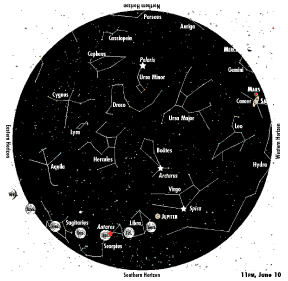The Green Dragon of the East
Dusk unveils Mercury, Mars, Saturn and Jupiter, while Venus rises due east a couple hours before sunrise, around 5:45 this week. The sun sets around 8:30 this week, and as it settles beneath the west-northwest horizon, a bright light appears in its wake: Mercury.
Mercury never strays far from the sun, providing us just a few glimpses each year either just before sunrise or just after sunset. Mercury circles the sun in a extreme elliptical orbit, passing within 27 million miles but then swinging away more than 41 million miles as if trying to escape the sun’s torturing presence. The second smallest planet in out solar system, Mercury is dwarfed by Saturn’s moon Titan and Jupiter’s moon Ganymede. Mercury is one of the least studied planets, having hosted no unmanned explorers, although Mariner 10 was launched in 2004 and should arrive in 2009. Even the Hubble Space Telescope cannot reveal Mercury’s secrets, as the planet keeps so close to the sun. Over the next few weeks, explore Mercury for yourself as it reaches its farthest from the sun.
Mars and Saturn shine from due west at sunset, closing the gap over the next week until the two are less than one-third degree apart.
Jupiter rules the heavens as the brightest light other than sun and moon, appearing high in the south at sunset and setting in the southwest around 3:30, just a couple hours before daybreak. Look for Jupiter near the full “Strawberry” or “Rose” moon Thursday night and Saturday evening just a couple degrees below the red giant Antares, the heart of the scorpion.
In Chinese mythology, Antares is the heart of the Green Dragon of the East, Cang Long, a massive constellation that includes Spica and Arcturus as the dragon’s two long horns and represents the divine essence of all nature.